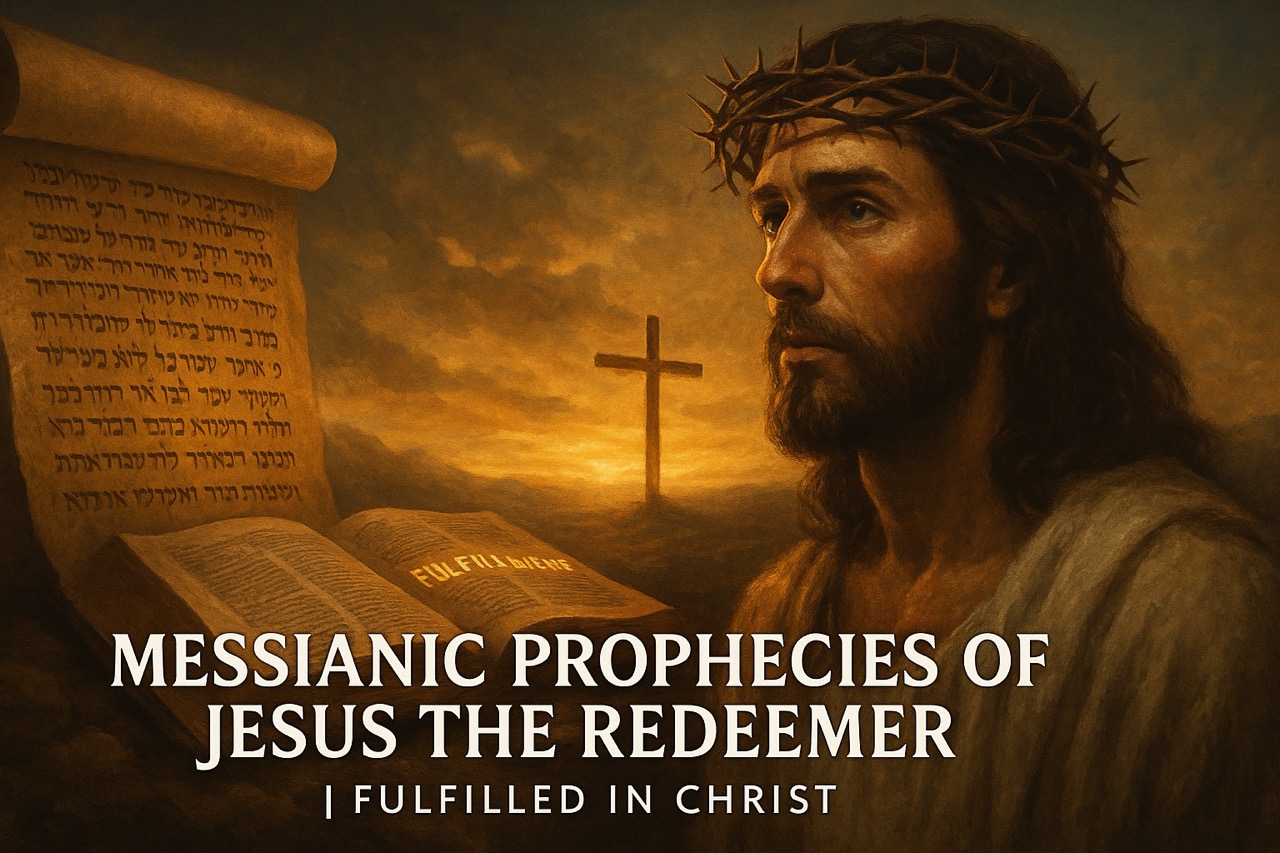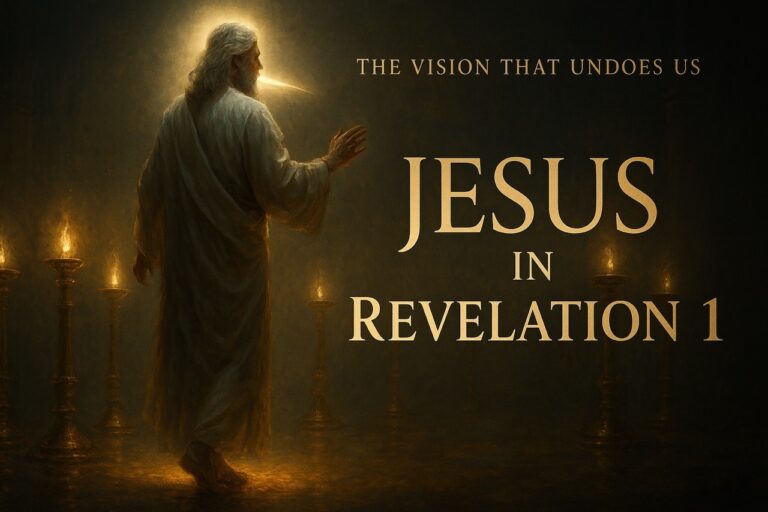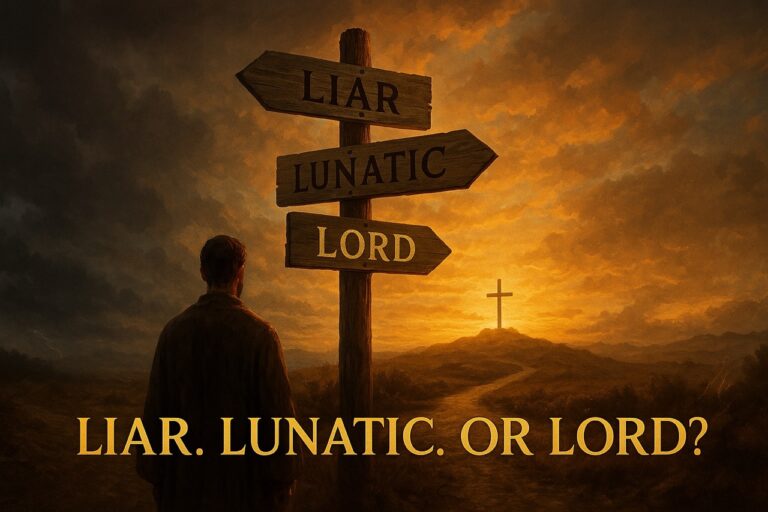From Genesis to Isaiah, the Bible reveals a consistent hope: messianic prophecies of Jesus the Redeemer — one who would bear our sins and bring salvation to the world.
These ancient prophecies aren’t vague predictions. They’re divine promises fulfilled in Jesus Christ, the Lamb of God, the Kinsman-Redeemer, and the one who makes atonement once and for all.
In this study, we explore how Jesus fulfills these messianic prophecies through His sacrifice, His blood, and His eternal role as the Savior foretold.
📖 “The Lord has laid on Him the iniquity of us all.” — Isaiah 53:6
Let’s uncover how Jesus fulfills these ancient prophecies — and why His redemption changes everything.
💀 They didn’t die for a lie.
See how all of Jesus’s disciples died — and what it proves.
Want the full breakdown of fulfilled messianic prophecy?
View our master guide: 351 Prophecies Jesus Fulfilled in Scripture →
✝️ Want to go EVEN deeper?
Explore the historical evidence of Jesus through ancient writings, Roman records, and archaeological discoveries that confirm His life and crucifixion. 🔍 Read the full article →
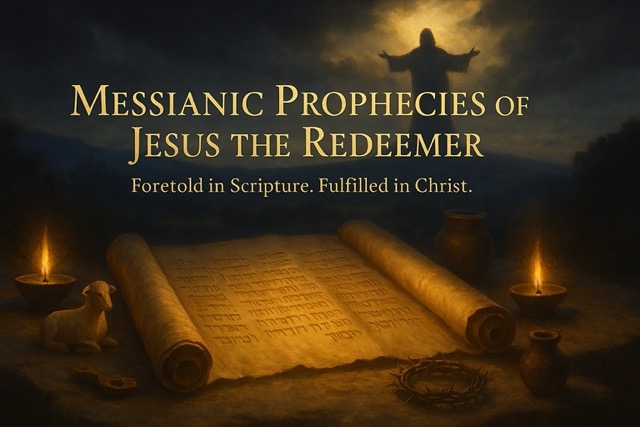
📖 What Are the Messianic Prophecies of Jesus the Redeemer?
In biblical terms, a Redeemer (Hebrew: goel) is someone who pays a price to buy back what was lost. The concept appears throughout the Old Testament — from family members rescuing relatives from slavery, to priests offering blood sacrifices for sin, to God Himself declaring, “I will redeem you with an outstretched arm” (Exodus 6:6).
messianic prophecies of Jesus the Redeemer show how God prepared His people to recognize the Messiah not just as a ruler… but as a rescuer.
Throughout Scripture, we see two key patterns:
- Direct Prophecies: Clear promises of a future Redeemer who will bear sins, bring forgiveness, and establish a new covenant. (e.g., Isaiah 53, Jeremiah 31)
- Typological Foreshadowing: People and rituals that symbolically point to Jesus — such as the Passover lamb, the scapegoat on the Day of Atonement, or Boaz redeeming Ruth.
These ancient patterns converge in one person: Jesus Christ.
He is the Lamb who takes away sin. The Priest who makes final atonement. The Kinsman-Redeemer who brings us home. And every prophecy fulfilled by Him proves the Scriptures true — and His salvation complete.
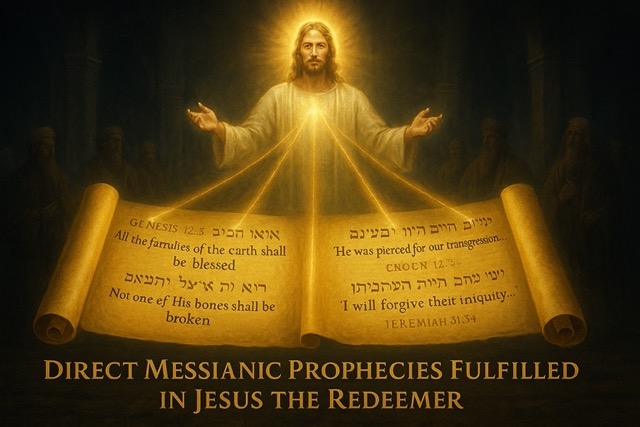
✝️ Direct Messianic Prophecies of Jesus the Redeemer
These Old Testament prophecies don’t just hint at redemption — they explicitly describe the work of the Messiah as a sin-bearer, covenant maker, and suffering Savior. The New Testament authors repeatedly cite these verses as direct fulfillments in Jesus Christ.
Each of the following prophecies unveils part of the Redeemer’s mission — from global blessing to substitutionary atonement.
🌍 Genesis 12:3 — A Global Blessing Through Abraham
“In you all the families of the earth shall be blessed.”
— Genesis 12:3
Fulfillment: Acts 3:25–26, Galatians 3:8, Matthew 1:1
God’s covenant with Abraham promised that his descendant would bring blessing to every nation. The New Testament affirms that this “seed” is Jesus — through whom salvation spreads to all families of the earth. This prophecy establishes a global scope for redemption.
💡 This verse isn’t just about land or lineage — it’s about the Redeemer who would extend mercy to every tribe and tongue.
🕊️ Isaiah 53:4–6, 8, 12 — The Suffering Servant Who Bore Sin
“He was pierced for our transgressions… and the Lord has laid on Him the iniquity of us all.”
— Isaiah 53:5–6
Fulfillment: Matthew 8:17, Romans 5:6–8, 1 Peter 2:24
This is the clearest prophecy describing Jesus as the suffering Redeemer. Isaiah paints a portrait of a Servant who suffers not for His own sins, but ours. He is “crushed,” “pierced,” and ultimately “pours out His soul unto death” to justify many.
✝️ Quoted over 10 times in the New Testament, Isaiah 53 stands at the heart of Christ’s atoning work.
🕎 Exodus 12:3–6, 12:46 — The Passover Lamb
“Each man is to take a lamb… without blemish… and not one of its bones shall be broken.”
— Exodus 12:3–6, 12:46
Fulfillment: John 1:29, John 19:36, 1 Corinthians 5:7
The original Passover was both historical event and sacred symbol. Each Israelite family placed lamb’s blood on their doorposts, and death passed over them. This lamb pointed forward to Jesus — the Lamb of God — unblemished, innocent, whose blood delivers us from judgment.
🩸 John explicitly declares Jesus as the Lamb. His bones were not broken during crucifixion, fulfilling this prophecy to the letter.
📜 Jeremiah 31:31–34 — The New Covenant of Forgiveness
“I will forgive their iniquity and remember their sin no more.”
— Jeremiah 31:34
Fulfillment: Hebrews 8:6–13, Luke 22:20
Jeremiah prophesied a new covenant — not written on stone, but on hearts. A covenant defined by forgiveness, intimacy with God, and transformation from within. Jesus declares at the Last Supper: “This is the new covenant in My blood.”
🕯️ Through His death and resurrection, Jesus made this covenant real — offering grace not through law, but through love.
✍️ Summary of Fulfillments in This Section
| Old Testament Prophecy | Fulfilled In Jesus |
|---|---|
| Genesis 12:3 — Global blessing | Acts 3:25–26, Gal. 3:8 |
| Isaiah 53 — Sin-bearing Servant | Rom. 5:6–8, 1 Pet. 2:24 |
| Exodus 12 — Passover Lamb | John 1:29, 19:36 |
| Jeremiah 31 — New Covenant | Hebrews 8:6–13, Luke 22:20 |
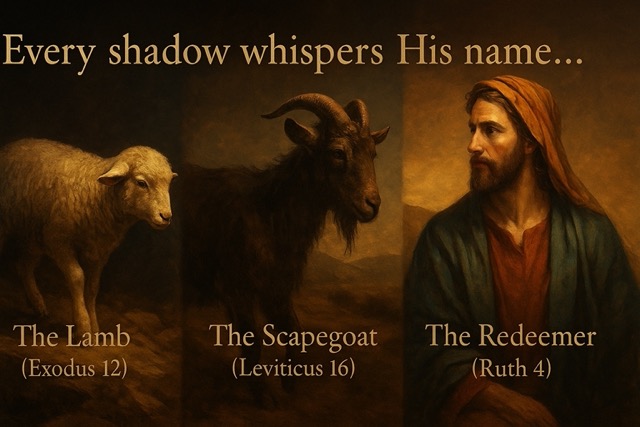
🪔 Typological Messianic Foreshadowing of Jesus the Redeemer
Some of the most powerful messianic prophecies of Jesus the Redeemer are not spoken as direct predictions — but seen in stories, symbols, and sacred rituals that point forward to Him. These types are God’s divine foreshadowing, preparing hearts to recognize the Redeemer when He came.
Let’s explore three vivid typologies that reveal Jesus as Savior, Lamb, and Kinsman-Redeemer.
🌾 Ruth 4: Boaz as the Kinsman-Redeemer
“I have bought from the hand of Naomi all that belonged to Elimelek… also Ruth… I have acquired as my wife.”
— Ruth 4:9–10
Fulfillment: Ephesians 1:3–7, Hebrews 2:11
In ancient Israel, a goel (kinsman-redeemer) had the legal right to redeem land, name, or family from ruin. Boaz steps in to redeem Ruth and restore Naomi’s family line — not out of duty, but love. This act of selfless redemption foreshadows Jesus, our spiritual Redeemer.
✝️ Jesus, as both God and man, became our kinsman — and through His blood, redeemed us from sin, shame, and spiritual widowhood.
📖 “In Him we have redemption through His blood, the forgiveness of sins…” — Ephesians 1:7
🐐 Leviticus 16: The Day of Atonement and the Scapegoat
“He shall lay both hands on the head of the live goat… and send it away into the wilderness, bearing all their iniquities.”
— Leviticus 16:21–22
Fulfillment: Hebrews 9:11–14, 2 Corinthians 5:21
On Yom Kippur, Israel’s high priest placed the sins of the people onto a live goat — the scapegoat — which was led into the wilderness, symbolically removing their sin. This act prefigured Christ, who bore our sins and carried them away, once and for all.
🕊️ Jesus didn’t just symbolically carry sin — He became sin for us, fulfilling the true meaning of atonement.
📖 “God made Him who knew no sin to be sin for us…” — 2 Corinthians 5:21
🐑 Exodus 12: The Passover Lamb (Typological View)
This isn’t just a direct prophecy — it’s also a deeply layered symbol. Each Passover lamb had to be:
- Without blemish
- Chosen on the 10th day
- Slaughtered at twilight
- Bones unbroken
- Blood applied to save from death
Jesus fulfills each detail of this sacred typology: the sinless Lamb, willingly offered, whose blood brings eternal protection.
🩸 When John declared, “Behold the Lamb of God,” he was pointing directly to the Passover shadow made real.
✍️ Typological Summary
| Old Testament Symbol | Messianic Fulfillment |
|---|---|
| Boaz as goel (Ruth 4) | Jesus redeems His Bride (Eph. 1:7) |
| Scapegoat (Lev. 16) | Christ bears and removes sin (2 Cor. 5:21) |
| Passover Lamb (Ex. 12) | Jesus as Lamb of God (John 1:29) |

🔍 Hebrew Words in Messianic Prophecies of Jesus the Redeemer: Ga’al & Kaphar
To fully grasp the messianic prophecies of Jesus the Redeemer, we must understand the sacred language behind the promise. The Old Testament doesn’t just describe what the Redeemer would do — it embeds His mission in the very Hebrew words used for redemption and atonement.
These words aren’t just theological terms… they’re prophetic codes pointing directly to Jesus.
✨ גָּאַל (Ga’al) — “To Redeem, Buy Back, Restore”
- Strong’s Concordance: H1350
- Definition: To redeem, act as kinsman-redeemer, buy back from slavery, restore inheritance
- Usage: Ruth 4:4, Leviticus 25:25, Isaiah 59:20
In the story of Ruth, ga’al describes Boaz’s act of redemption — legally reclaiming what was lost and restoring dignity. Throughout the Torah and Prophets, God is also called Israel’s Go’el — their Redeemer who saves them from bondage.
✝️ Jesus fulfills this word by becoming our kinsman — one with us in flesh — and paying the ultimate price to redeem us from sin and death.
📖 “The Redeemer (Go’el) will come to Zion…” — Isaiah 59:20
🩸 כָּפַר (Kaphar) — “To Cover, Atonement, Reconcile”
- Strong’s Concordance: H3722
- Definition: To cover over, pacify, purge, make atonement
- Usage: Leviticus 16:15–17, Exodus 30:10, Numbers 29:5
This is the root of Yom Kippur — the Day of Atonement. In Leviticus, the priest enters the Holy of Holies and sprinkles blood to kaphar for the people’s sins. The concept here isn’t just covering — it’s reconciliation through sacrifice.
🕊️ Jesus doesn’t just cover sin — He removes it through His once-for-all atonement.
📖 “He entered the Most Holy Place once for all… having obtained eternal redemption.” — Hebrews 9:12
📌 Word Study Summary
| Hebrew Word | Meaning | Fulfilled in Jesus |
|---|---|---|
| Ga’al (גָּאַל) | To redeem, buy back | Jesus as our Kinsman-Redeemer (Titus 2:14) |
| Kaphar (כָּפַר) | To atone, cover | Jesus as our Atonement (Heb. 9:12, Rom. 3:25) |
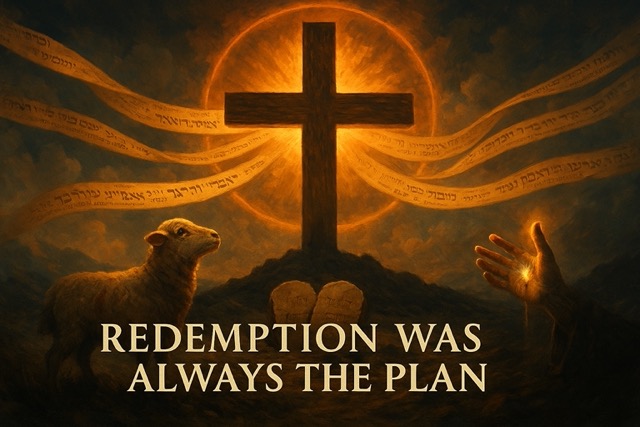
🧠 Why Messianic Prophecies Required Jesus the Redeemer
The messianic prophecies of Jesus the Redeemer are not merely poetic — they reflect a divine necessity. Redemption wasn’t optional. It was essential for God’s justice, love, and covenant promises to meet at the cross.
But why did Jesus have to be the one to fulfill them?
✝️ 1. Only a Sinless Sacrifice Could Satisfy Justice
The Scriptures declare: “Without the shedding of blood there is no forgiveness of sins” (Hebrews 9:22). The law required a spotless offering. Animal sacrifices in the Old Testament temporarily covered sin — but they were never enough (Hebrews 10:4).
Jesus, fully God and fully man, lived a sinless life and offered Himself as the perfect Lamb. This was not only fulfillment — it was final.
📖 “Christ offered for all time a single sacrifice for sins.” — Hebrews 10:12
🕊️ 2. Redemption Requires a Willing Kinsman
Under Mosaic law, only a kinsman — a blood-relative — could redeem family property or people (Leviticus 25:25). Boaz fulfilled this role for Ruth. Jesus fulfills it for all of humanity by taking on flesh and blood (Hebrews 2:14–17).
🩸 He became like us… so He could die for us.
This is why the incarnation matters. Jesus had to be fully human to redeem humans — and fully divine to do it perfectly.
📜 3. The New Covenant Demands a Mediator
Jeremiah 31 promised a new covenant of forgiveness and inward transformation. But a covenant requires a mediator. In Jesus, that promise is sealed in blood — not the blood of bulls and goats, but His own.
📖 “There is one mediator between God and man — the man Christ Jesus, who gave Himself as a ransom.” — 1 Timothy 2:5–6
He doesn’t just teach the covenant… He becomes it.
🧩 4. Prophecy, Typology, and History All Converge in Jesus
Every shadow in the Old Testament — the lamb, the scapegoat, the tabernacle veil, the priesthood, the blood — finds its meaning in Christ. Scholar Kevin DeYoung explains:
“Jesus’ death was a substitutionary sacrifice, a redemption, a reconciliation, and a propitiation… all at once.” — TGC
In Jesus, every thread of redemption converges. Without Him, the story remains unfinished.
🕯️ The Redeemer’s Mission: Fulfilled and Final
Jesus did not simply fulfill prophecy like checking boxes on a scroll. He fulfilled God’s heart — to rescue the lost, to forgive the guilty, to redeem what was ruined. His cross was not an afterthought. It was the center of history.
And every prophecy, every foreshadow, every ancient word whispered: The Redeemer is coming… and He will not fail.
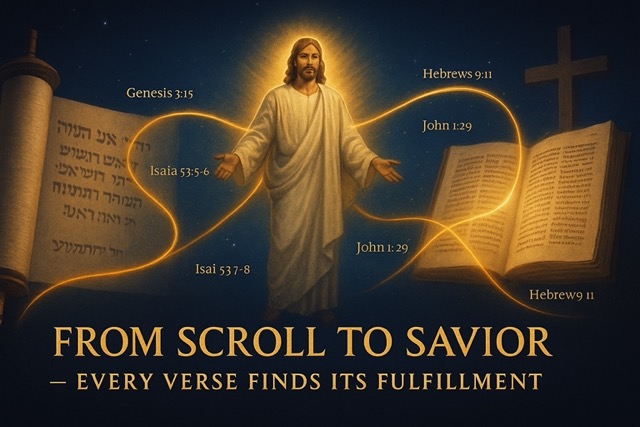
🔗 Related Scriptures Fulfilling Messianic Prophecies of Jesus the Redeemer
These supporting Bible verses help frame the full scope of Jesus’ redemptive role — confirming how prophecy, typology, and gospel fulfillment intersect across both testaments.
📖 Cross-References:
- Genesis 3:15 — “He shall bruise your head…”
➤ The first prophecy of a coming Savior who will defeat sin and Satan. - Galatians 3:13–14 — “Christ redeemed us from the curse of the law…”
➤ Direct link to Jesus as Redeemer, fulfilling the covenant made with Abraham. - 1 Corinthians 5:7 — “Christ, our Passover lamb, has been sacrificed.”
➤ Connects the Exodus lamb directly to Jesus’ atoning death. - Hebrews 9:11–14 — “He entered the greater and more perfect tent… by His own blood.”
➤ Jesus as High Priest and final sacrifice — fulfilling Levitical law. - Romans 3:25 — “God presented Christ as a sacrifice of atonement.”
➤ Paul uses hilasterion — the same Greek word for mercy seat.
🗂️ Prophecy Fulfillment Chart
| Prophecy Source | Theme | Fulfilled In |
|---|---|---|
| Genesis 12:3 | Global blessing through Abraham | Acts 3:25, Gal. 3:8 |
| Exodus 12 | Passover lamb, no broken bones | John 1:29, 19:36 |
| Leviticus 16 | Day of Atonement, scapegoat | Hebrews 9:11–14 |
| Ruth 4 | Kinsman-redeemer, legal redemption | Ephesians 1:7, Hebrews 2:14 |
| Psalm 32 | Forgiveness of sin through grace | Romans 4:6–8 |
| Isaiah 53 | Substitutionary suffering | Matthew 8:17, 1 Peter 2:24 |
| Jeremiah 31 | New covenant & forgiveness | Hebrews 8:6–12, Luke 22:20 |
📚 Further Study Tools & Resources
Explore these trusted resources for deeper study and reflection:
- Salvation by Propitiation – Kevin DeYoung (The Gospel Coalition)
A theological exploration of how Jesus’ death satisfies God’s justice, emphasizing the necessity and significance of propitiation in salvation. - The Wrath of God Was Satisfied – Jon Bloom (Desiring God)
A powerful reflection on Isaiah 53 and the concept of substitutionary atonement, highlighting the depth of God’s love demonstrated through Christ’s sacrifice. - What is a Kinsman Redeemer? – GotQuestions.org
A clear and concise explanation of the role of the kinsman-redeemer in biblical times and how Jesus fulfills this role for humanity. - Study Guide for Exodus 12 – David Guzik (Blue Letter Bible)
An in-depth commentary on the Passover, drawing connections between the sacrificial lamb and Jesus as the ultimate Passover Lamb. - Sacrifice and Atonement – The Bible Project
A visual and theological exploration of the themes of sacrifice and atonement throughout the Bible, culminating in the work of Jesus.
🔗 Explore Related Articles on Paranoid Prophet
These internal studies expand on themes found in this article — from fulfilled prophecy to the nature of Christ’s redemption:
Who Is God? Biblical Attributes Explained
Unpack the character of the God who sends the Redeemer.
Prophecies of Jesus Fulfilled in Scripture
Your master guide to 351 fulfilled messianic prophecies, organized by category.
Prophecies About Jesus’s Birth and Early Life
Dive into the miraculous and foretold beginnings of Christ’s earthly mission.
Prophecies About Jesus’s Ministry
See how Christ’s teachings, healings, and mission were all foreshadowed in Scripture.
Eschatological Prophecies of Jesus: His Return, Reign, and the New Creation
Explore the second half of the redemptive arc — Jesus as reigning King.
Was Jesus a Liar? Examining the Evidence Against Deception
Apologetics insight into the moral integrity and divine mission of Christ.
Was Jesus a Madman? Analyzing the Evidence for His Sanity
Tackling the question of mental clarity and Jesus’ radical claims.
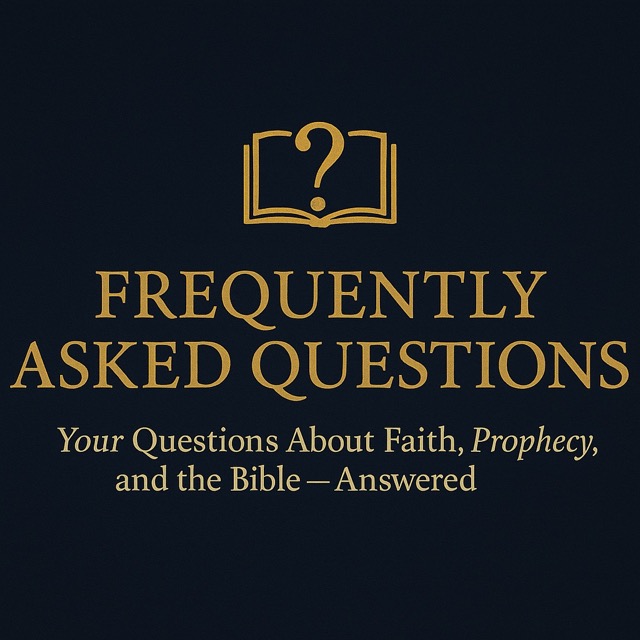
❓ Frequently Asked Questions About Messianic Prophecies of Jesus the Redeemer
🔹 What Are Messianic Prophecies of Jesus the Redeemer?
Messianic prophecies refer to Old Testament passages that foretold the coming of a Savior — one who would redeem, restore, and reconcile humanity to God. These prophecies appear in books like Genesis, Exodus, Isaiah, Psalms, and Jeremiah. Some are direct promises (e.g., Isaiah 53), while others use symbolic figures (like the Passover lamb or scapegoat) to foreshadow the Messiah’s role.
🔹 How Did Jesus Fulfill These Ancient Prophecies?
Jesus fulfilled over 300 messianic prophecies through His birth, life, death, and resurrection.
- His birth in Bethlehem fulfilled Micah 5:2
- His suffering and death fulfilled Isaiah 53 and Psalm 22
- His resurrection fulfilled Psalm 16:10
The New Testament constantly echoes Old Testament language to confirm that Jesus is the promised Messiah.
🔹 What Does It Mean That Jesus Is Our Redeemer?
In Hebrew, the word go’el (גָּאַל) means redeemer — one who buys back what was lost, often through blood or legal kinship.
- In Ruth 4, Boaz redeems Naomi’s family
- In Leviticus, redemption laws protect property and lineage
Jesus fulfills this as both our Kinsman (fully human) and our Savior (fully divine), offering His life to restore us to God.
🔹 Which Old Testament Rituals Symbolically Point to Jesus?
The Old Testament contains rituals designed to foreshadow Christ’s redemptive mission:
- Passover Lamb (Exodus 12): Innocent blood saves from death
- Day of Atonement (Leviticus 16): The scapegoat bears the sins of the people
- Kinsman-Redeemer (Ruth 4): Legal redemption through family love
- The Mercy Seat (Exodus 25): Place of atonement between God and man
Jesus fulfills all of these by becoming the true Lamb, High Priest, Scapegoat, and Mercy Seat in one person.
🔹 Where Does the Bible Say Jesus Fulfilled Prophecy?
The New Testament explicitly connects Jesus to prophecy:
- Matthew 1:22: “All this took place to fulfill…”
- Acts 3:18: “God fulfilled what He foretold through all the prophets…”
- Hebrews 10: Christ’s sacrifice replaces the Law’s offerings
This repeated formula — “to fulfill what was written” — affirms that Jesus is the long-anticipated Redeemer.
🔹 What Do the Hebrew Words “Ga’al” and “Kaphar” Mean?
Two key Hebrew words unlock Jesus’ redemptive role:
Ga’al (גָּאַל) — To redeem, restore, buy back
- Used in Ruth 4, Isaiah 59, Leviticus 25
- Jesus becomes our Kinsman-Redeemer, legally and lovingly reclaiming us
Kaphar (כָּפַר) — To atone, cover, reconcile
- Root of Yom Kippur (Day of Atonement)
- Jesus’ blood doesn’t just cover sin — it removes it permanently
These words are embedded in the fabric of prophecy — fulfilled fully in Christ.
🔹 Why Did Jesus Have to Suffer to Fulfill Redemption?
Biblically, redemption requires sacrifice. Hebrews 9:22 says, “Without the shedding of blood there is no forgiveness.”
Animal sacrifices offered only temporary atonement. But Jesus, being perfect, offered a once-for-all sacrifice — fully satisfying God’s justice.
His suffering wasn’t random. Isaiah 53:10 says it was the Lord’s will “to crush Him.” He suffered willingly… to save us eternally.
🔹 Are There More Prophecies Than Isaiah 53?
Yes — there are many more, including:
- Genesis 3:15 — The first prophecy of a Savior
- Psalm 22 — A vivid depiction of crucifixion
- Zechariah 12:10 — “They will look on Me whom they pierced”
- Micah 5:2 — Predicts the Messiah’s birthplace
- Jeremiah 31 — The New Covenant fulfilled by Christ
These texts provide overwhelming prophetic consistency — fulfilled in detail by Jesus.
🔹 How Does Typology Prove Jesus Is the Messiah?
Typology is when people or events in the Old Testament symbolically foreshadow Christ. Here are a few key examples:
- Joseph — Betrayed by brothers, saved his family (Genesis 37–50)
- Boaz — Redeems Ruth in love, not law (Ruth 4)
- Scapegoat — Sent away with the people’s guilt (Leviticus 16)
- Tabernacle/Mercy Seat — God’s presence and atonement (Exodus 25)
Jesus is the real fulfillment of every type — the ultimate Savior, Lamb, Redeemer, and High Priest.

